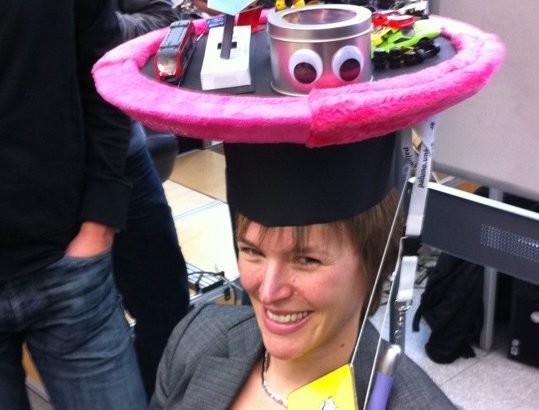 Dagmar Kern has successfully defended her PhD on “Supporting the Development Process of Multimodal and Natural Automotive User Interfaces” in Essen. External examiner was Antonio Krüger from University of Saarbrücken. Her dissertation will be available online soon. The core contribution of the thesis is the investigation of how to improve a user centered design process for automotive user interfaces. In order to systematically assess user interface designs in cars she developed a design space (inspired by Card et al [5]). In various cases studies she create novel in-car user interfaces and explored experimentally the implications on driver distraction.
Dagmar Kern has successfully defended her PhD on “Supporting the Development Process of Multimodal and Natural Automotive User Interfaces” in Essen. External examiner was Antonio Krüger from University of Saarbrücken. Her dissertation will be available online soon. The core contribution of the thesis is the investigation of how to improve a user centered design process for automotive user interfaces. In order to systematically assess user interface designs in cars she developed a design space (inspired by Card et al [5]). In various cases studies she create novel in-car user interfaces and explored experimentally the implications on driver distraction.
 Dagmar started working with me as a student of Media Informatics at the LMU Munich in 2005, then jointed my group at Fraunhofer IAIS/BIT in Bonn and move in 2007 with the group to Essen. She was for a short research stay in Saarbrücken and Milton Keynes and was extremely productive over the last years – 18 publications she co-authored are listed in DBLP and here are some highlights of here research:
Dagmar started working with me as a student of Media Informatics at the LMU Munich in 2005, then jointed my group at Fraunhofer IAIS/BIT in Bonn and move in 2007 with the group to Essen. She was for a short research stay in Saarbrücken and Milton Keynes and was extremely productive over the last years – 18 publications she co-authored are listed in DBLP and here are some highlights of here research:
- exploration of how to present navigation information (e.g. vibra tactile steering wheel) [1]
- gazemarks – an approach to aid attention switching between the road and an in car display using eye gaze date [2]
- a multi-touch steering wheel, that reduced driver distraction [3]
- a design space for automotive user interfaces [4]
Additionally to the publications one of the side products of here thesis is the CARS open source driving simulator. It is a configurable low cost simulator that can be used to measure driver distraction, e.g. as an alternative to LCT.
Dagmar’s defense brought us back to Essen and it was great to meet many colleagues again. We finally managed to have a group photo taken with nearly all the team (Elba is missing in the Photo).
The doctoral hat may look strange to non-Germans but it has some funny tradition. It is hand crafted by the colleagues and each of the items on the hat tells a story – usually known to the group but in the best case hard to guess for outsiders. Besides others Dagmar’s hat included a scrap heap of cars, a giraffe, a personal vibration device, a yoyo, a railway station building side, and a steering wheel cover.
[1] Dagmar Kern, Paul Marshall, Eva Hornecker, Yvonne Rogers, and Albrecht Schmidt. 2009. Enhancing Navigation Information with Tactile Output Embedded into the Steering Wheel. InProceedings of the 7th International Conference on Pervasive Computing (Pervasive ’09). Springer-Verlag, Berlin, Heidelberg, 42-58. DOI=10.1007/978-3-642-01516-8_5 (free PDF)
[2] Dagmar Kern, Paul Marshall, and Albrecht Schmidt. 2010. Gazemarks: gaze-based visual placeholders to ease attention switching. In Proceedings of the 28th international conference on Human factors in computing systems (CHI ’10). ACM, New York, NY, USA, 2093-2102. DOI=10.1145/1753326.1753646 (free PDF)
[3] Tanja Döring, Dagmar Kern, Paul Marshall, Max Pfeiffer, Johannes Schöning, Volker Gruhn, and Albrecht Schmidt. 2011. Gestural interaction on the steering wheel: reducing the visual demand. In Proceedings of the 2011 annual conference on Human factors in computing systems (CHI ’11). ACM, New York, NY, USA, 483-492. DOI=10.1145/1978942.1979010 (free PDF)
[4] Dagmar Kern and Albrecht Schmidt. 2009. Design space for driver-based automotive user interfaces. In Proceedings of the 1st International Conference on Automotive User Interfaces and Interactive Vehicular Applications (AutomotiveUI ’09). ACM, New York, NY, USA, 3-10. DOI=10.1145/1620509.1620511 (free PDF)
[5] Stuart K. Card, Jock D. Mackinlay, and George G. Robertson. 1991. A morphological analysis of the design space of input devices. ACM Trans. Inf. Syst. 9, 2 (April 1991), 99-122. DOI=10.1145/123078.128726















